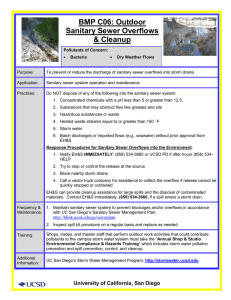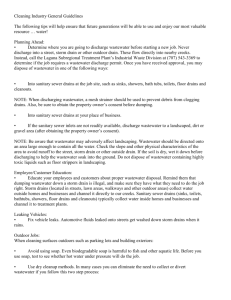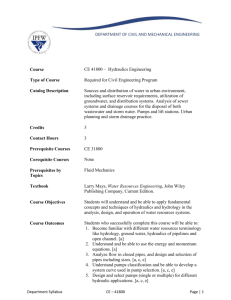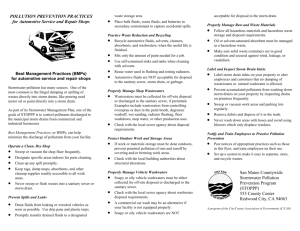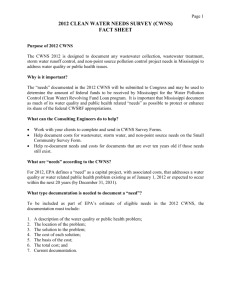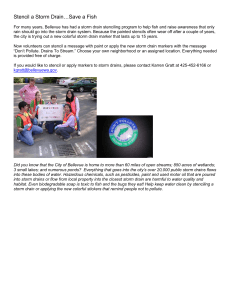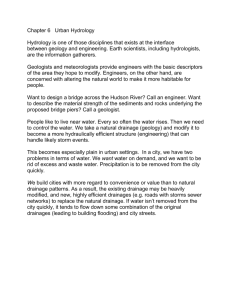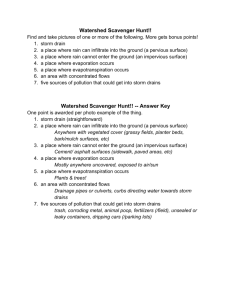Auto Detailer Guidelines
advertisement
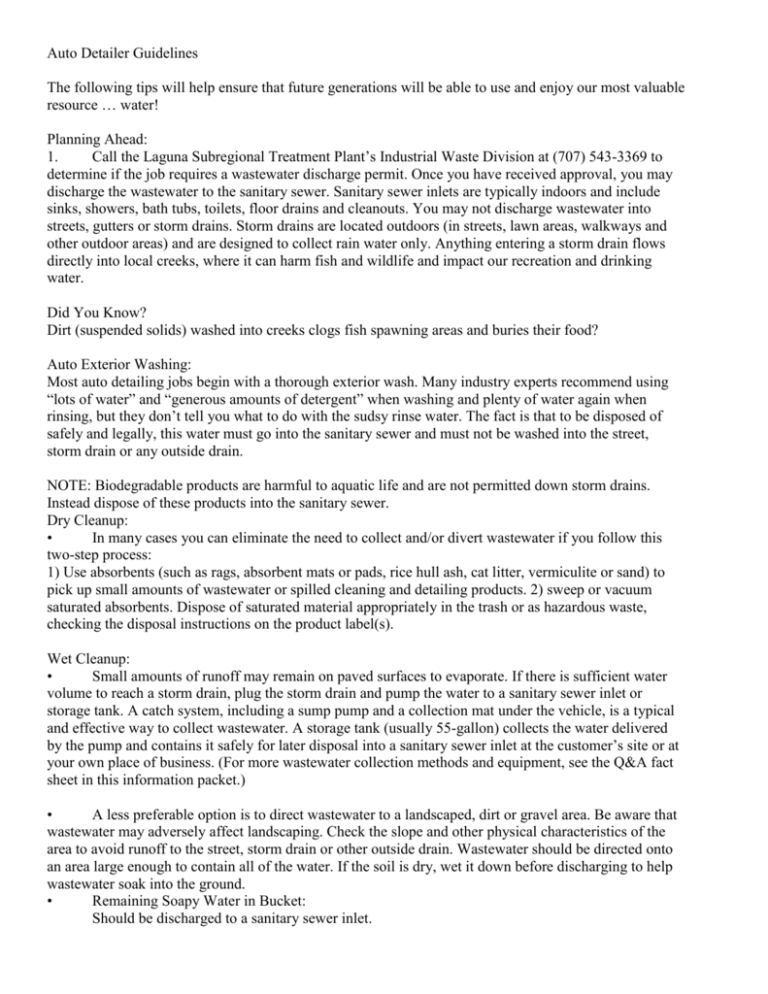
Auto Detailer Guidelines The following tips will help ensure that future generations will be able to use and enjoy our most valuable resource … water! Planning Ahead: 1. Call the Laguna Subregional Treatment Plant’s Industrial Waste Division at (707) 543-3369 to determine if the job requires a wastewater discharge permit. Once you have received approval, you may discharge the wastewater to the sanitary sewer. Sanitary sewer inlets are typically indoors and include sinks, showers, bath tubs, toilets, floor drains and cleanouts. You may not discharge wastewater into streets, gutters or storm drains. Storm drains are located outdoors (in streets, lawn areas, walkways and other outdoor areas) and are designed to collect rain water only. Anything entering a storm drain flows directly into local creeks, where it can harm fish and wildlife and impact our recreation and drinking water. Did You Know? Dirt (suspended solids) washed into creeks clogs fish spawning areas and buries their food? Auto Exterior Washing: Most auto detailing jobs begin with a thorough exterior wash. Many industry experts recommend using “lots of water” and “generous amounts of detergent” when washing and plenty of water again when rinsing, but they don’t tell you what to do with the sudsy rinse water. The fact is that to be disposed of safely and legally, this water must go into the sanitary sewer and must not be washed into the street, storm drain or any outside drain. NOTE: Biodegradable products are harmful to aquatic life and are not permitted down storm drains. Instead dispose of these products into the sanitary sewer. Dry Cleanup: • In many cases you can eliminate the need to collect and/or divert wastewater if you follow this two-step process: 1) Use absorbents (such as rags, absorbent mats or pads, rice hull ash, cat litter, vermiculite or sand) to pick up small amounts of wastewater or spilled cleaning and detailing products. 2) sweep or vacuum saturated absorbents. Dispose of saturated material appropriately in the trash or as hazardous waste, checking the disposal instructions on the product label(s). Wet Cleanup: • Small amounts of runoff may remain on paved surfaces to evaporate. If there is sufficient water volume to reach a storm drain, plug the storm drain and pump the water to a sanitary sewer inlet or storage tank. A catch system, including a sump pump and a collection mat under the vehicle, is a typical and effective way to collect wastewater. A storage tank (usually 55-gallon) collects the water delivered by the pump and contains it safely for later disposal into a sanitary sewer inlet at the customer’s site or at your own place of business. (For more wastewater collection methods and equipment, see the Q&A fact sheet in this information packet.) • A less preferable option is to direct wastewater to a landscaped, dirt or gravel area. Be aware that wastewater may adversely affect landscaping. Check the slope and other physical characteristics of the area to avoid runoff to the street, storm drain or other outside drain. Wastewater should be directed onto an area large enough to contain all of the water. If the soil is dry, wet it down before discharging to help wastewater soak into the ground. • Remaining Soapy Water in Bucket: Should be discharged to a sanitary sewer inlet. If a sanitary sewer inlet is not available, this small quantity of wastewater may be distributed over a dirt or gravel area. Bug & Tar Removal The solvents used to remove stubborn grit and tar from car bodies and windshields are not allowed down storm drains as they are harmful to aquatic life. Use cloths to apply and remove these materials, then store them safely for future disposal as a hazardous waste.* Glass Cleaning Most glass cleaners contain ammonia. Did you know that ammonia is harmful to fish and stimulates abnormal algae and plant growth? Some cleaners also contain alcohol and a variety of detergents. These materials are not allowed down storm drains, as they are harmful to aquatic life.* Use rags to pick up spilled glass cleaner. *Call the Sonoma County EcoDesk (707-565-DESK) for a list of approved hazardous waste recyclers and disposal sites or to find out how small businesses can dispose of hazardous waste at a local drop-off event (instead of hiring a hazardous waste hauler). In general, you must generate less than 27 gallons or 220 pounds of a particular type of waste each month to qualify to use these “Conditionally Exempt Small Quantity Generator” (CESQG) programs. Auto Interior Cleaning Vacuuming Dispose of debris in a trash container. Do not sweep debris into the street. Carpet Cleaning Foam carpet cleaners are recommended by most detailing experts. These cleaners are easily contained; however, care should be taken that no residues are washed into storm drains. Floor Mats If washing mats outside of the car, wastewater must be contained and disposed safely and legally. (See Wet Cleanup under Auto Exterior Washing section on the reverse side of this sheet.) Vinyl Many recommend biodegradable products for cleaning vinyl surfaces, such as dashboards and interior doors. Even biodegradable cleaning products are harmful to fish and other aquatic life and are not permitted down storm drains. Spill Prevention & Control: • Before spills occur, train all employees in spill prevention and cleanup. • Post a Spill Cleanup Plan inside the company vehicle. • Place spill cleanup materials in highly accessible locations inside the company vehicle. • Purchase and maintain the proper materials for containment and cleanup of different spills. These include rags, absorbents (such as cat litter or rice hull ash), absorbent pads, oleophilic pads (absorb oil but not water), drip pans, absorbent booms to contain spills, and storm drain covers. • Fix company vehicle leaks. Automobile fluids leaked onto streets get washed down storm drains when it rains. Many of these Best Management Practices were provided by San Francisco Bay Area CETA (Cleaning Equipment Trade Association) and by the Bay Area Stormwater Management Agencies Association (BASMAA).

